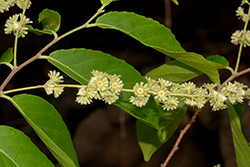e-Flora of Thailand
Volume 13 > Part 1 > Year 2015 > Page 41 > Salicaceae > Homalium
4. Homalium dasyanthum (Turcz.) W.Theob.wfo-0000926236
Burmah [Mason], ed. 3. 2: 451. 1883; Craib, Fl. Siam. 1: 739. 1931; Sleumer, Fl. Males., Ser. I, Spermat. 5: 56, fig. 25. 1954; Lescot, Fl. Cambodge, Laos & Vietnam 11: 93, pl. X. 1970; Sleumer, Blumea 30: 222. 1985.— Blakwellia dasyantha Turcz., Bull. Soc. Imp. Naturalistes Moscou xxxvi: 610. 1863. Plate V: 2.
Accepted Name : This is currently accepted.
Description : Tree to 20 m, pale grey bark; branchlets with a sparse to dense indumentum, usually a mixture of short and long straggly spreading hairs. Stipules linear to lanceolate, to 3 mm. Leaves with petiole to 8 mm long, indumentum as on branchlets; blade mostly elliptic, sometimes somewhat ovate or obovate, to 13 by 6 cm, base obtuse to somewhat cordate, often asymmetrical, apex acute to acuminate; both surfaces with short or long spreading hairs, usually dense on midrib and sparse elsewhere; hairy domatia often present in vein axils. Inflorescence main axis to 15 cm long, indumentum as on branchlets; bracts on main axis linear to ovate, to 3 mm long, usually much smaller, each subtending a short branch (to 2 mm long); these short branches either terminating with a flower, or with a few short branches at their apex, each of these terminated by a flower. Flowers on pedicels to 1 mm long, 9–12-merous. Calyx tube to 3 mm long, dense appressed to ascending mixture of short and long hairs; sepals linear or lanceolate, to 3 mm long, dense appressed long hairs outside, glabrous or sparsely hairy inside. Petals oblong to obovate, to 4 mm long, dense appressed to ascending hairs outside, sparser inside, margin with prominent long cilia. Disc glands with dense short hairs. Stamens two opposite each petal, one between disc glands and the other at base of ovary, to 3 mm long, filaments glabrous. Ovary with long spreading hairs, relatively dense outside, sparse inside; styles 3–5, to 2 mm long, erect or recurved.
Thailand : SOUTH-WESTERN: Prachuap Khiri Khan; CENTRAL: Saraburi; SOUTH- EASTERN: Chachoengsao, Trat; PENINSULAR: Chumpon, Ranong, Surat Thani, Phangnga, Phuket, Krabi, Nakhon Si Thammarat, Trang, Satun, Songkhla.
Distribution : Indochina, Lower Myanmar (type), Peninsular Malaysia.
Ecology : In evergreen or mixed deciduous forests, at low altitudes close to the coast.
Vernacular : Kring liang (กริ่งเลียง)(Surat Thani); khon ta chang (ขนตาช้าง)(Chumphon); khao kwang (เขากวาง)(Peninsular); cham pun (จำปูน)(Prachuap Khiri Khan); chi mut (ชีหมุด)(Surat Thani); tam sao nu (ตำเสาหนู)(Krabi).
Notes: Homalium dasyanthum and H. foetidum are the only two Homalium species in Thailand with two stamens opposite each petal. The inflorescence structure of the two species is very different, and H. dasyanthum also has long appressed hairs on the outer surface of the petals, in contrast to short straggly hairs for H. foetidum.


